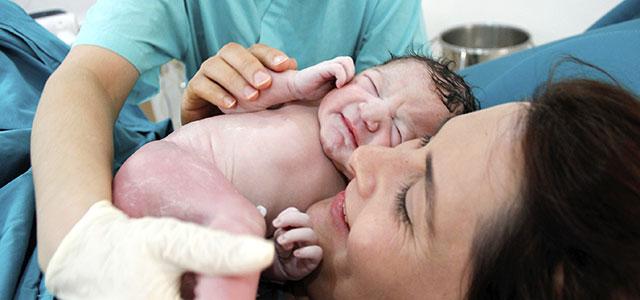
New Blueprint Seeks to Improve Patient Safety During Childbirth
Driven by a rising maternal mortality rate in the US, three influential women’s health care journals have jointly published a blueprint for improving communication and safety in the care of women during childbirth. The paper – whose lead author was UC San Francisco School of Nursing faculty member Audrey Lyndon – identified communication problems among clinicians, patients, families and administrators as a major concern that needs to be addressed.
Unprecedented Collaboration
While the reasons for the rising mortality rate remain unclear, “Every organization involved in providing care for women during labor and birth needs to take this on as something that they’re going to solve,” says Lyndon.
As part of an unprecedented cooperative effort between several such organizations – including the American College of Nurse Midwives, the American Congress of Obstetricians and Gynecologists, the Association of Women’s Health, Obstetric and Neonatal Nurses and the Society for Maternal-Fetal Medicine – Lyndon and colleagues from these groups did two initial studies to identify the patient safety issues confronting nurses, midwives, physicians and others involved in maternity care. These studies uncovered communication problems and disconnects between clinicians and administrators as key threats to patient safety.
“These are human problems, not just nurse or doctor problems,” says Lyndon, who notes that the contributing factors – and there are many – exist across all disciplines and settings.
For example, training and cultural differences among clinicians and embedded hierarchies can stifle respectful dialogue. Cost issues can come into play, as when administrators and clinicians disagree over safe staffing levels. In some settings, people from across the organization simply deny that a problem exists. At the most basic level, says Lyndon, is interpersonal interaction: how people treat each other on a daily basis affects how well individuals are able to do their jobs, which can carry over into patient care.
Putting Communication First
 Audrey Lyndon The paper makes a number of recommendations. One of the most important of them stems from the recognition that successful organizations make communication a safety priority. “It’s about making a commitment to taking this as seriously as we do any other major safety initiative,” she says. “You’re never going to get the penetration you need to affect people’s behavior if the whole organization isn’t behind it.”
Audrey Lyndon The paper makes a number of recommendations. One of the most important of them stems from the recognition that successful organizations make communication a safety priority. “It’s about making a commitment to taking this as seriously as we do any other major safety initiative,” she says. “You’re never going to get the penetration you need to affect people’s behavior if the whole organization isn’t behind it.”
Once the organization prioritizes communication, it can address specific concerns around teamwork and accountability. Perinatal units have unique challenges because childbirth is dynamic and involves lots of judgment calls from a variety of clinicians. One example: the nurse, who is usually the clinician monitoring the labor, needs to be competent and able to communicate concerns clearly to a physician or midwife, who must be responsive, because – as Lyndon points out – while most labors go smoothly, a few turn catastrophic very quickly.
Moreover, clinicians must constantly be aware they are communicating with and around a patient (and family) who is usually quite engaged. “It’s challenging because, even if everything is fine right now, you might be a little worried that X, Y or Z may happen,” says Lyndon. “You might want to have a conversation about it without alarming the woman or her family.”
The blueprint helps organizations understand how to address these challenges by offering examples of potential sources of miscommunication or conflict and outlining specific approaches, such as ensuring patients are included in decisionmaking, or instituting a mechanism for reporting safety-related incidents anonymously. There are several case studies of organizations that have undertaken serious, team-based efforts at improving patient safety, including a Department of Veterans Affairs project that significantly decreased surgical mortality and New York Presbyterian/Weill Cornell Medical Center’s creation of a nurse position specifically to implement a perinatal safety program.
As Lyndon says, “There is no perfect model. We don’t know what the next unexpected thing is going to be, so we really need to hone the team skills for identifying and addressing hazards.”



